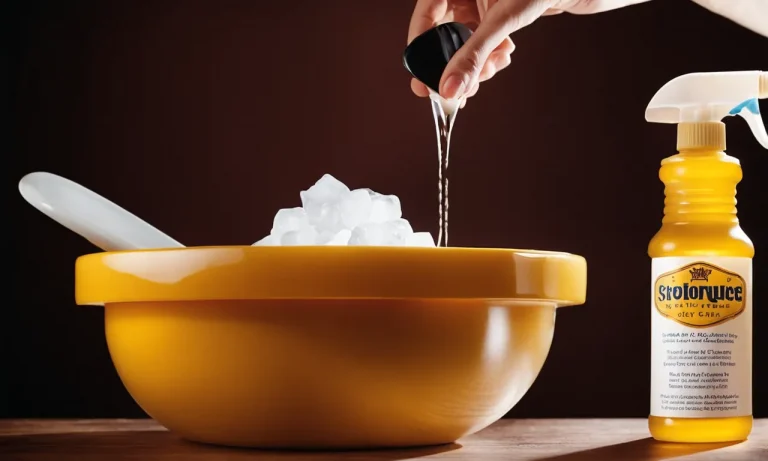How To Get Putty Out Of Fabric: A Step-By-Step Guide
Sticky putty can be super fun to play with, but it can also create a messy situation when it gets stuck on fabric surfaces. If you’ve ever had the misfortune of getting putty stuck on your clothes, furniture, or carpets, you know how annoying it can be to try and remove it.
If you’re short on time, here’s a quick answer to your question: The best way to get putty out of fabric is to first try peeling or scraping off any excess putty. Then, use an ice cube to harden the putty so it’s easier to flick off.
For any remaining residue, apply some WD-40 or Goo Gone and let it sit for 5 minutes before scrubbing with a clean cloth or sponge.
Supplies You Will Need
– Plastic scraper or blunt knife
To remove putty from fabric, you will need a plastic scraper or a blunt knife. These tools will help you gently lift and scrape off the putty without damaging the fabric. Be careful not to use anything sharp that could tear or snag the fabric.
– Tweezers
Tweezers can be useful for picking out any small pieces of putty that are stuck in the fabric fibers. They provide precision and control, allowing you to carefully remove the residue without spreading it further.
– Ice cubes
Before attempting to remove the putty, it’s a good idea to freeze it first. Place a few ice cubes in a plastic bag and hold it against the putty for a few minutes. The cold temperature will harden the putty, making it easier to remove.
– WD-40 or Goo Gone
If the putty is particularly stubborn, you may need to use a solvent like WD-40 or Goo Gone. Apply a small amount of the solvent to a clean cloth and gently dab at the putty, allowing it to break down.
Be sure to test the solvent on a small, inconspicuous area of the fabric first to ensure it doesn’t cause any damage or discoloration.
– Clean rags or paper towels
You will need clean rags or paper towels to blot and absorb any excess putty or solvent. These absorbent materials will help lift the putty off the fabric, preventing it from spreading or getting further embedded.
– Laundry detergent (for machine-washable fabrics)
If the fabric is machine-washable, you can use laundry detergent to remove any remaining residue. Apply a small amount of detergent directly to the affected area, gently rub it in, and then wash the fabric according to the care instructions.
– Toothbrush or scrub brush
A toothbrush or scrub brush can be helpful for agitating the putty and loosening it from the fabric fibers. Gently scrub the affected area in a circular motion, being careful not to scrub too vigorously and damage the fabric.
Step 1: Remove Excess Putty
– Carefully pick off any large, easy-to-remove chunks of putty with your fingers.
When dealing with putty on fabric, the first step is to remove any excess putty. Start by carefully picking off any large, easy-to-remove chunks of putty with your fingers. Be gentle to avoid spreading the putty further into the fabric.
– Use a plastic scraper or blunt knife to gently lift off as much putty as possible.
If there are still remaining bits of putty on the fabric, use a plastic scraper or blunt knife to gently lift off as much putty as possible. Make sure to use a tool that won’t damage or tear the fabric. Slowly and carefully scrape off the putty, working from the outer edges towards the center.
– Pull at the putty slowly. Going too fast may cause it to rip the fabric.
When removing putty from fabric, it’s important to be patient and go slow. Pull at the putty slowly, as going too fast may cause it to rip the fabric. Apply gentle pressure and gradually work the putty off the fabric. Remember, haste makes waste!
– For small pieces stuck in fabric crevices, use tweezers to precisely pick them out.
If there are small pieces of putty stuck in fabric crevices or hard-to-reach areas, tweezers can be a handy tool. Use the tweezers to precisely pick out the small pieces of putty, being careful not to snag or damage the fabric. Take your time and remove the putty bit by bit.
For more detailed instructions and visual demonstrations, you can check out websites like Stain-Removal-101 or Cleanipedia, which provide step-by-step guides on removing putty from fabric.
Step 2: Harden the Putty with Ice
Once you’ve identified the putty stain on your fabric, it’s time to start removing it. One effective method is to harden the putty using ice. Here’s how you can do it:
– Place a few ice cubes in a plastic bag and wrap in a paper towel.
Gather a few ice cubes and place them in a plastic bag. To prevent direct contact between the ice and the fabric, it’s a good idea to wrap the bag in a paper towel. This extra layer will help protect the fabric from getting too wet or damaged.
– Press the ice pack onto the putty stain for 1-2 minutes.
Take the ice pack and gently press it onto the putty stain. Apply slight pressure and hold it in place for about 1-2 minutes. The cold temperature from the ice will cause the putty to harden, making it easier to remove from the fabric.
– The cold temperature will harden the putty, making it easier to remove.
The science behind this method lies in the effect of cold temperature on the putty. When exposed to low temperatures, the putty becomes more solid and less sticky. This allows you to remove it more easily without leaving a residue on the fabric.
– Once hardened, flick the putty off the fabric with your fingers.
After the 1-2 minutes have passed, carefully remove the ice pack from the fabric. You’ll notice that the putty has hardened and is no longer as malleable. To remove it, simply flick it off the fabric using your fingers.
– Repeat icing and flicking until you’ve removed as much putty as possible.
If there is still some putty residue left on the fabric, don’t worry. You can repeat the icing and flicking process until you’ve removed as much putty as possible. This method is safe to use on most fabrics, but be sure to test it on a small, inconspicuous area first to ensure there are no adverse effects.
Remember, getting putty out of fabric can be a bit of a challenge, but with the right techniques and a little patience, you can restore your fabric to its former state. So, grab some ice and get started on removing that stubborn putty stain!
Step 3: Use a Solvent to Dissolve Putty Residue
– Put a small amount of WD-40 or Goo Gone onto a clean cloth or paper towel.
When it comes to removing putty stains from fabric, using a solvent can be highly effective. Two common solvents that work well for this purpose are WD-40 and Goo Gone. These solvents are readily available in most households or can be purchased at your local hardware store.
To begin, put a small amount of either WD-40 or Goo Gone onto a clean cloth or paper towel.
– Gently rub the solvent over any remaining putty stains.
Once you have applied the solvent to the cloth or paper towel, gently rub it over any remaining putty stains on the fabric. Be sure to use a light touch to avoid damaging the fabric. The solvent will work to break down the putty and make it easier to remove.
– Allow it to sit for 3-5 minutes to penetrate and dissolve the putty.
After you have rubbed the solvent onto the stained area, allow it to sit for a few minutes to properly penetrate and dissolve the putty. This will give the solvent enough time to work its magic and loosen the putty from the fabric fibers.
– Wipe away the solvent and any dissolved putty residue.
Using a clean cloth or paper towel, wipe away the solvent along with any dissolved putty residue. You may need to repeat this step a few times to ensure all traces of the putty and solvent are removed. Make sure to use a fresh cloth or paper towel each time to avoid spreading the stain further.
– Repeat as needed until the stain is gone.
If there are still remnants of the putty stain, don’t worry. Simply repeat the previous steps until the stain is completely gone. Persistence is key when it comes to removing stubborn stains. Keep applying the solvent, allowing it to sit, and wiping away the residue until your fabric is clean and putty-free.
Remember to always follow the instructions provided on the solvent’s packaging and test it on a small, inconspicuous area of the fabric before applying it to the stained area. This will help ensure that the solvent does not cause any damage or discoloration to the fabric.
Step 4: Scrub Away Remaining Traces of Putty
– For light-colored fabrics, make a paste of laundry detergent and warm water.
When it comes to removing putty from light-colored fabrics, a simple paste made of laundry detergent and warm water can be highly effective. The detergent helps to break down the oily properties of the putty, making it easier to remove.
Mix a small amount of detergent with warm water until it forms a paste-like consistency.
– Use an old toothbrush or scrub brush to work the detergent paste into the stain.
Once you have the detergent paste ready, take an old toothbrush or scrub brush and start gently scrubbing the paste into the putty stain. Make sure to cover the entire affected area and focus on the stained spots.
The bristles of the toothbrush or scrub brush will help to loosen the putty from the fabric fibers.
– Rinse the paste out thoroughly with clean water.
After scrubbing the detergent paste into the stain, it’s time to rinse it out. Use clean water and thoroughly rinse the fabric until all the detergent and putty residue is gone. Make sure to rinse both sides of the fabric to ensure a complete removal.
– Air dry the fabric or machine wash on a normal cycle.
Once the fabric is rinsed clean, you have two options for drying it. You can either air dry the fabric by laying it flat or hanging it up, allowing it to naturally dry. Alternatively, you can machine wash the fabric on a normal cycle, following the care instructions on the garment.
Choose the method that is most suitable for the fabric and your preferences.
– This scrubbing action should remove any last traces of putty.
By following these steps and giving a thorough scrubbing to the putty stain, you should be able to remove any last traces of putty from the fabric. Remember to be patient and persistent in your scrubbing, as it may take some time for the putty to completely come off.
Once the fabric is dry, check for any remaining residue and repeat the process if necessary.
Conclusion
Getting putty out of fabric can be tedious, but with the right techniques and supplies, it can be done. First try peeling and scraping to remove excess putty. Then harden remaining residue with ice cubes and flick it away. Solvents like WD-40 or Goo Gone will dissolve any remaining stain.
Finally, a good scrub with detergent should get rid of any last traces. With some patience and elbow grease, you can outsmart troublesome putty stains. Just be careful using sharp tools on delicate fabrics, work slowly, and test cleaning methods in an inconspicuous area first.







